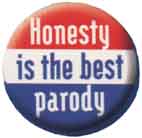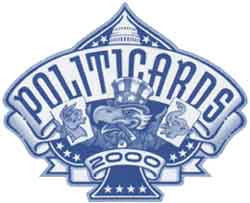Politicards 2000 by Action Publishing
Politicards 2000 features 54, full colour, caricatures of the candidates, politicians and political pundits shaping the American presidential elections in 2000
The caricatures are reproduced on a 54 card poker deck which is cello-wrapped with an index card and a folded paper insert (listing contact information for the politicians and a brief voter registration guide) and inserted into a 4-color tuck box which is again cello-wrapped.







"Politicians are the servants of the people. They do the right things when we, the people, tell them what we want…"

Above: Each card depicts an humorous caricature of a personality in the U.S. presidential election to be held on November 7, 2000. Gone are the days of sober politicians steeped in gravitas and dignity with only a hint of irony… here they are blatantly satirised and caught in acts which they would rather were forgotten. 52 premium quality cards + 2 jokers + title card + explanatory leaflet in sturdy tuck box, cellowrapped. The cards are printed at Carta Mundi's US plant in Kingsport, Tennessee using "Corona 305" 2-ply playing card stock imported from Carta Mundi in Belgium. Publisher & Art Director: Michael Metzler. Published by: Action Publishing, P.O. Box 391, Glendale, CA 91209, U.S.A. Website: www.politicards.com.

Christopher Smith does the initial research to develop the list of potential politicians to include and concepts for the caricatures.
The list is narrowed down and the concepts refined at a series of editorial meetings with Peter Green drawing "on-the-fly".
The illustrations progress those rough sketches to tight pencil on tissue. The tight pencil drawing is photocopied.
The photocopy is inked using black marker and colored using Dr. Marten's Water Color Dies and Prismacolor pencils.
Designers: Peter Green & Michael Manoogian
Logo design, lettering and packaging design comps are done using pencil and marker tissue sketches, pen and ink, markers, color papers and a stat camera.
Production artist and Photoshop wizard: Allen Harris
Power Mac 9600 with 704 megs of RAM
Radius PressView 17" montior
Photoshop 5
Illustrator 8
Quark 4
Canon 700 color with Cyclone RIP (for design proofs, NOT final color)
Silicon Graphics O2 server
Most of the packaging is created in Photoshop. Allen thoughtfully plans and builds the Photoshop images in layered files so they remain editable throughout the production cycle. Although this technique depends on have the disk space and processing power to handle large layered files, it allows for the fast revisions or reverting to an earlier version that are inevitable is a project like this.
Scanning: Ardash Derian, DigiLith Graphics, Inc.
DS Screen 608 drum scanner
DS Image Setter
Mac G3
Fuji Color Art proofs
A series of test scans of the illustrations were with four potential vendors before selecting Digilith. Digilith ran a further series of tests and then scanned paper density and subtracted paper density from the colour tone in illustrations. Created colour scale from that and matched the colour scale for the remaining 54 illustrations. Only 5 of the 54 scans needed further colour correction.
Printing: Carta Mundi, Inc
The card manufacturing starts with conventional film (we printed at 150 dpi) that is proofed with Fuji proofing system on the paper used in the finished product.
The plates are burned on a Cortron Step and Repeat Unit. The cards themselves are run two decks (110 cards) up. Cards, tuck boxes and display materials are printed and varnished on a Mitsubishi 54" 5 colour.
The essential elements that make a playing card a playing card are the paper and varnish.
A. Paper is 2 ply playing card stock. Most stock is from mills in Germany and France. It is laminated with a black graphite glue that guarantees that they are opaque.
B. The "playing card varnish" is a custom formula (most major card makers have their own formulas). The varnish helps determine the "slip" and feel of the cards (how they move against each other) and protects the cards from skin oil and dirt.
The full 2-up sheets of cards are fed into what Carta Mundi calls their "Integrated Slitter Combi Line". This is a custom, Carta Mundi-designed piece of equipment manufactured by Gemstar that looks like a combination of a model train set and a NASA Mars lander. It slits the sheets, cuts them, assembles the deck, trims the rounded corners, drops in any custom cards or instruction sheets that may have been produced off-line, inserts the complete deck into the tuck box and wraps them with a Martin Edwards Cello Wrapping unit. All this without, theoretically, interruption or human intervention.
Decks are packed into displays and/or shipping cartons by hand.
Notes and review deck kindly provided by Michael Metzler.

By Simon Wintle
Member since February 01, 1996
I am the founder of The World of Playing Cards (est. 1996), a website dedicated to the history, artistry and cultural significance of playing cards and tarot. Over the years I have researched various areas of the subject, acquired and traded collections and contributed as a committee member of the IPCS and graphics editor of The Playing-Card journal. Having lived in Chile, England, Wales, and now Spain, these experiences have shaped my work and passion for playing cards. Amongst my achievements is producing a limited-edition replica of a 17th-century English pack using woodblocks and stencils—a labour of love. Today, the World of Playing Cards is a global collaborative project, with my son Adam serving as the technical driving force behind its development. His innovative efforts have helped shape the site into the thriving hub it is today. You are warmly invited to become a contributor and share your enthusiasm.
Related Articles

Modern Swiss-German Pattern (carta.media)
Modernizing tradition: balancing clarity and continuity in regional card design.

Nimbus playing cards
Mike Steer’s weather-themed pack with suits in four colours and backs for cardistry.

Rap Rummy
Rap Rummy made by Parker Brothers in 1926, only 4 years after the discovery of King Tutankhamen’s to...

Jeu Révolutionnaire
Court cards and aces from a French Revolutionary pack by Pinaut, Paris, c.1794.

German Travel Cards
A travel-themed educational deck helping American tourists visiting Germany.

Can You Believe Your Eyes?
“Can You Believe Your Eyes?” playing cards featuring visual illusions & other oddities.

Doppel-Deutsche Karten by Bratří Willnerové, Teplice
This deck from local manufacturer Bratří Willnerová offers a standard version of the popular Central...

Zürcher Festspiel 1903
Swiss-suited pack designed by Robert Hardmeyer featuring figures from art and politics.

Never Mind the Belote
Limited edition Belote pack with designs by a collective of 24 street artists.

Get Decked
Black and white cartoons devised by Sam Wagner with help from artist Lindsay Bevington.

Beowulf
Jackson Robinson's Beowulf playing card deck inspired by the Old English pagan poem.

Keith Haring playing cards
Energetic graffiti images by the American artist Keith Haring.

Barok
Dutch pack from the 1950s with colourful Baroque courts, reprinted in 1983.

The Tarot of Meditation – Yeager Tarot
Marty Yeager’s original Tarot of Meditation from 1975, republished later by U.S. Games Systems, Inc....

Adobe Deck
The first digitally-produced deck of cards.

Seminole Wars deck
Seminole Wars deck by J. Y. Humphreys, Philadelphia, c.1819.
Most Popular
Our top articles from the past 28 days

